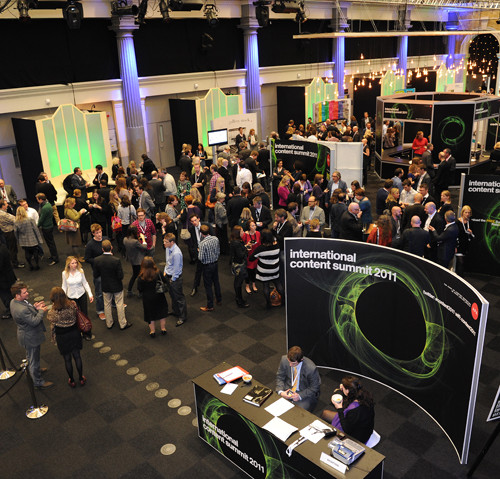This is part 2 of the summary of the 2011 APA International Content Summit, if you haven’t done so already, read part 1 – The Future of Content.
Keynote speaker Will Sansom (Writer and consultant at Contagious) kicked off the afternoon session at APA’s second International Content Summit: Content and Conversion.
He first identified an emerging trend of “dude we should do” mentality – the practice of doing things because you think you should, rather than knowing why you should. To move away from this he made three suggestions:
- Augmented content: Taking what already exists and making it more fun, more relevant and more interesting. Heinekin’s Star Player app demonstrates the value of this approach by adding your own instincts to a real time football match. The secret for augmented content is that it has to add value to what people are already engaging with, not distract them from it – that’s just annoying.
- Reality of real time: contrary to popular belief we do not have real life and virtual life, they are now indistinct. Marketers need to use real time media to bring people closer to the brand. Burberry’s Tweetwalk where Burberry’s followers were sent pictures of the models before they went onto the runway shows the label’s commitment to engaging their customers as it was happening
- The culture of self: the fact that content and technology needs to blend to personalise the brand experience. An example was a musical changing room in Singapore, which made the music in a clothing store fitting room match the clothes that were being tried on, i.e. if the person was trying on a pair of baggy jeans the music became hip-hoppy. Ultimately, this campaign made the content relevant to the individual at that specific time giving a completely seamless personal sensory experience
The future for content is about connecting the dots between useful, relevant and entertaining and doing things for real, individual people.
Following on from Will’s theme of self, the first panel session of the afternoon centred on how to maintain local credibility whilst having a global presence, a significant challenge for some of the world’s biggest brands.
Allyson Stewart-Allen (Director of International Marketing Partners) was first up to the stage and started by identifying some localisation clangers, such as the Matador car model which in most countries is associated with machismo, but in one key market translates literally as murderer. Or Starbucks’ Trenta 30-ounce cup size, which turned off coffee drinkers in the EU in their droves, but flew off the counters in the US. Clearly making things relevant for local territories is fundamental and many of the largest brands are recognising this such as Lays crisps developing a kiwi fruit flavour specifically for the Chinese market. However, it’s not just important for product development, but on a smaller scale too. The production of content has to have local nuances or it risks alienating an enormous segment of customers.
Next up was Jonathan Foster Kenny (VP International sales Director at Bloomberg Business Week) who explained why companies need to think globally and act locally. A global strategy is important because companies are increasingly doing business around the world; exposure to a brand in different markets is now more common as international travel continues to grow and finally the internet where anyone has access to the company no matter where they live. Consequently, the global strategy ties the brand together, but to avoid potential disasters, the strategy should be executed or at least moderated locally where there is understanding of the customer.
Greet Boonen (Marketing Director, Consumer brands EMEA at AkzoNobel) took the issue from a theoretical stance to practical application. A delegate from 2010, she explained how last year’s summit irrevocably altered their global content strategy and shared how they had updated their approach to bring together ,but empower, their local brands. AkzoNobel is the largest paint manufacturer in the world with brands including Dulux. They started by creating a uniform global identity which was rolled out across all the local brands, but used the content strategy to enable those brands to engage their own markets by telling local stories, such as the sad story of Charleloi, voted the ugliest town in Belgium, which was given a facelift by the company.
Sam Wilkin (Head of Business research Oxford Economics), completed the line up and took the mantle of localisation further by stating the business case. Author of The Kimchi Matters, he took delegates on a whistle stop tour of why distance matters; distances within language, regional trading bloc, country-coloniser relationship, common coloniser, common political system and common currency. At the most umbrella level, the more distant you are from your customers the less engaged they will be. Consequently to inherently appeal to a variety of nationalities it is vital to have a local appreciation.
Session Five saw four eminent brands taking the podium to discuss the content ideal and share their experiences in how to achieve it.
Ruth Spencer (Head of Loyalty, Boots), talked about the challenges of making Boots personal to those consumers that want it. To this end Boots discovered that customers wanted them to take more ownership of all the touch points available to them from customer magazines through to direct email and websites. Boots now views it’s self as a media owner as well as a retailer and the three lessons it learnt in this journey were:
- Make the brand feel like the brand across all the channels
- Get integration right – there is no short cut, its dull work, but a necessary evil
- Play to each channel’s individual strengths by using them for different things
Myf Ryan (GM Marketing, Westfield UK) then shared the issues of launching Westfield Stratford City in the midst of the worst economic climate in years. The strategy was to create a voice for the shopping centre before it launched, with the objective attracting shoppers once the doors opened. They recognised that traditional press, whilst a viable channel, wasn’t enough on its own. They wanted to build a constantly evolving community and realised that editorialised content was key to this: finding the story and then telling it though different channels. The biggest success was a viral film that spread around the world. This was a media first for Westfield and it resulted in 3.5 million views and 27,000 tweets. Also noteworthy were the 30,000 likes on Facebook; an incredible accomplishment for a branded piece of content. The learning for this campaign is that audience is key they are not channel loyal but content loyal
Continuing the story telling theme, Sarah Tuke (Head of Media Communications at Coca-Cola) went on to speak about the collaborative approach to content that Coca Cola is now taking. This at its heart is not just thinking about what the content is and where it goes, but how it is created. The issue Coca Cola has, as many multinationals have, is that everyone has opinion. They made the decision to harness this. Using “the plant bottle”, Coca Cola’s greenest bottle yet, as a case study Sarah demonstrated how it is possible through collaboration to engender trust even on emotive issues like sustainability. Working with mums, influential groups and individuals like Red or Dead’s Wayen Hemmingway they devised the “recylometer” which helped consumers understand their impact on the environment. To date the results have been excellent including a 56% increase in visits to the website.
Through the medium of video, Simon Wood (Head of Operations, Marks and Spencer Direct) demonstrated the success of content TV as a both a brand building and sales tool. M&S TV, which can be viewed on the web, mobile, social media, YouTube or through syndicated content on third party sites has, since launch boosted sales significantly but also encouraged customers to spend longer with the brand. Using the example of a recent campaign to find a new presenter for the channel, he showed just how compelling a medium video is as a differentiator for retailers.
Finally, in the last session of the day, Ben Hammersley (technologist, journalist and broadcaster) gave a very motivating keynote speech to leave delegates with food for thought and a feeling of optimism in the face of the continued economic gloom.
He reminded the audience that the world is difficult to predict and uncertainty surrounds us. There are endless calls to innovate, to become more social, to gamify, to co-create, to get the basics down pat. But what is right? The secret is very simple; it is to make good stuff. Make them true, make them beautiful, and make them better. And to do this, keep doing what you do.
Next year the APA International Content Summit will be held on 28th November.

2011 APA International Content Summit






